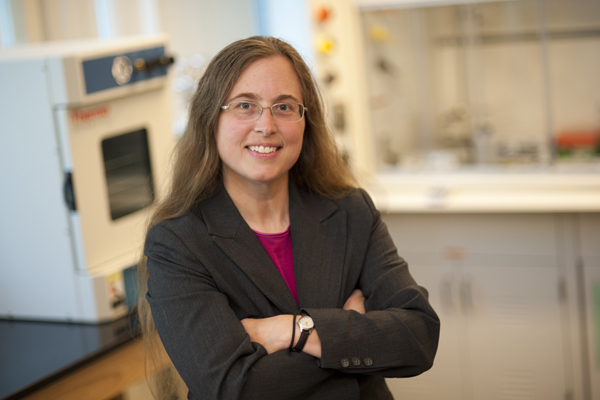Origami unfolds a new tissue engineering strategy

Origami, the Japanese art of paper folding, has been around for more than a millennium, but associate professor of mechanical and industrial engineering Carol Livermore is now using it to create solutions in an emerging multidisciplinary field in medicine: tissue engineering.
“There are lots of reasons to wish that we could make human spare parts,” said Livermore, whose new research is backed by a $2 million grant from the National Science Foundation’s Emerging Frontiers in Research and Innovation program and the Air Force Office of Scientific Research.
The problem with most tissue engineering approaches, however, is that there is a trade off between time and control. That is, simply mixing up a tissue’s cellular ingredients won’t yield a functioning tissue.
In previous work, Livermore and her team developed a novel technique that allows for the controlled self-assembly of small objects such as spheres or human cells into specific locations on two-dimensional surfaces, ranging from glass to different types of polymers.
“The thing that’s slick about this technique,” said Livermore, “is that you take a horrific mixed up mess of different objects and they sort themselves into the proper locations on the surface.”
By assembling different cell types—like those that make up blood vessels, for example, or liver tissue—onto a biocompatible scaffold, Livermore literally lays the foundation for a three-dimensional structure, such as an organ or large piece of tissue. The two-dimensional scaffold provides the “paper.” All she needs to do is fold it up.
“There are origami folds designed so if you hold onto a couple corners of the paper with the creases already in the right place, the whole thing folds itself up into a block,” she said, pointing to the so-called “Miura fold” as an example. With everything laid out in the right place on her two-dimensional cellular “paper,” these folds allow her to build a three dimensional block of tissue with blood vessels and other structures running through it.

Image via Wikimedia Commons.
Livermore will be working with a diverse group of researchers and origami experts. Robert Lang, the country’s most renowned origami artist, and Roger Alperin, a mathemetician and origami theorist, will help identify the best folding mechanisms for the job. Sangeeta Bhatia and Martin Culpepper, both of the Massachusetts Institute of Technology, will add their expertise in tissue engineering and precision mechanics, respectively.
Northeastern graduate student Majid Bigdeli Karimi will figure out how to lay out cells on the two-dimensional surface so that they will properly align themselves once folded. The big question here, said Livermore, is “how do you take an actual three-dimensional liver structure and best turn it into two dimensions?”
While we still can’t expect a mix of cells to automatically form into functioning tissue, Livermore’s approach may allow her to use that mix to create a two-dimensional base that, once artfully folded, will do just that.






